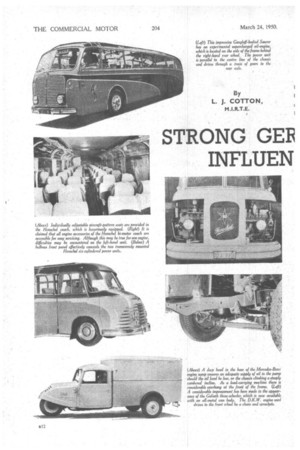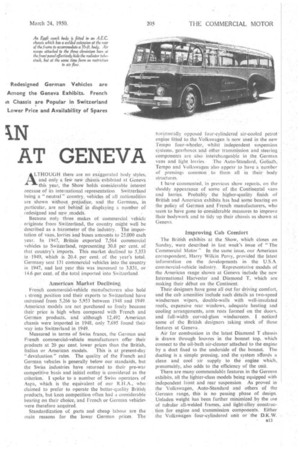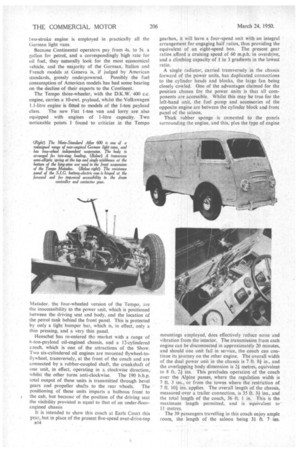STRONG GEE INFLUEN AT GENEVA
Page 46

Page 47

Page 48

Page 49

Page 50

If you've noticed an error in this article please click here to report it so we can fix it.
By 1 L. J. COTTON, m.i.R.T.E.
ATHOUGH there are no exaggerated body styles, and only a few new chassis -exhibited at Geneva this year, the Show holds considerable interest oecause of its international representation Switzerland being a "neutral " country, vehicles of all nationalities are shown Without prejudice, and the Germans, in particular, are not behind" in displaying a number of redesigned and nel.v models.
Because only three makes of commercial vehicle originate from Switzerland, the country might well be described, as a barometer of the industry. The importation of vans, lorries and buses amounts to 25,000 each year. In 1947, Britain exported 7,564 commercial vehicles to Switzerland, representing 30.8 per cent. of that country's imports. This market declined to 5,353 in '1949, which is 20.4. per cent. of the year's total. Germany sent 131 commercial vehicles into the country in 1947, and last year this was increased to 3,831, or 14.6 per, cent. of the total imported into Switzerland
American Market Declining • Frei-0 commercial-vehicle manufacturers also hold
strong position and their exports to .Switzerland have increased from 5,266 'to 5,953 between 1948 and 1949. American models are not purchased so freely because their price is high when compared with French and German products, and although 12,492 American chassis were imported in 1948, only 7,695 found their way into Switzerland in 1949.
Measured in terms of Swiss francs, the German and French commercial-vehicle manufacturers offer -their products at 20 per cent. lower prices than the British, Italian or American models. This is at present-day " devaluation " rates. The quality of the French and German vehicles is generally below our standards, but the Swiss industries have returned to their pre-war competitive basis and initial outlay is considered as the criterion. I spoke to a number of Swiss operators of Aspa, which is the equivalent of our R.H.A., who claimed to prefer to operate the better-quality British products, but keen competition often had a considerable • bearing on their choice, and French or German vehicles were therefore acquired.
Standardization of parts and cheap labour are the main reasons •for the lower German prices The
norizoritally opposed four-cylindered air-cooled petrol engine fitted to the,Volkswagen is now used in the new Tempo four-wheeler, whilst independent suspension systems. gearboxes and other transmission and steering compon6nis are also. interchangeable in the.. German vans and light lorries. The Auto-Standard, Goliath, Tempo and Volkswagen also apper to have a. 'number of pressings common . to them all in their body structures.
I. have. commented, in previous show reports, on the 'shoddy appearance of some of the Continental vans and lorries. Probably• the higher-quality finish of British and American 'exhibits has had some bearing on the policy of German and French manufacturers, who sceii to hav-e gone to• considerable measures to improve their bodywork and to tidy up their chassis as shown at Geneva.
Improving Cab Comfort The British exhibits at the Show, which closes on Sunday, were described in last week's issue of "The Commercial Motor" In the same issue. our American correspondent, Harry Wilkin Perry, provided the latest information on the developments in the U.S.A. commercial-vehicle indirstrY. Representative models of the American range shown at Geneva include the new International Harvester and Diamond T, which are making their debut on the Continent.
Their designers have gone all out for driving comfort, and the cab amenities include such details as two-speed windscreen wipers, double-walls with well-insulated roofs, expansive rear windows, adequate heating and cooling arrangements, arm rests formed on the doors, and full-width curved-glass = windscreens. I noticed some of the British designers taking stock of these features at Geneva.
Air for combustion in the latest Diamond T chassis is drawn through louvres in the bonnet top, which connect to the oil-bath air-cleaner attached to the engine by a duct fixed to the underside of the bonnet. The ducting is a simple pressing, and the ‘system affords a clean and cool air supply to the engine which, presumably, also adds to the efficiency of the unit.
There are many commendable features in the German exhibits, all the lighter-class models being equipped with independent front and rear suspension As proved in the Volkswagen, Auto-Standard and others of the German range, this is no passing phase of design. Unladen weight has been further minimized by the use of tubular all-welded frames, and tight-alloy construe. tiOn for engine and trarismissipn components. Either the Volkswagen four-cylindered unit or the D.K.W. B13 two-stroke engine is employed in practically all the German light vans.
Because Continental operators pay. from 4s. to 5s. a gallon for petrol, and a correspondingly high rate for oil fuel, they naturally look for the most economical vehicle, and the majority of the German. Italian and French models at Geneva is, if judged by American
standards, grossly underpowered. Possibly the fuel consumption of American models has had some bearing on the decline of their exports to the Continent.
The Tempo three-wheeler, with the D.K.W. 400 c.c. engine, carries a 10-cwt. payload, whilst the Volkswagen 1.1-litre engine is fitted to models of the 1-ton payload class. The new Fiat 1-ton van and lorry are also equipped with engines of 1-litre capacity. Two noticeable points I found to criticize in the Tempo Matador. the four-wheeled version of the Tempo, are the inaccessibility to the power unit, which is positioned between the driving seat and body, and the location of the petrol tank behind the front panel. This is protected by only a light bumper bar, which is, in effect, only a thin pressing, and a very thin panel.
Henschel has re-entered thz market with a range of 6-ton-payload oil-engined chassis, and a 12-cylindered caach, which is one of the attractions of the Show. Two six-cylindered oil engines are mounted flywheel-toflywheel, transversely, at the front of the coach and are connected by a rubber-coupled shaft, the crankshaft of one unit, in effect, operating in a clockwise direction, whilst the other turns anti-clockwise. The 190 b.h.p. total output of these units is transmitted through bevel
gears and propeller shafts to the rear wheels. The positioning of these units imparts a bulbous front to the cab, but because of the position of the driving seat the visibility provided is equal to that of an under-floorcngined chassis
It is intended to show this coach at Earls Court this year, but in place of the present five-speed over-drive-top B14 gearbox, it will have a four-speed unit with an integral arrangement for engaging half ratios, thus providing the equivalent of an eight-speed box. The present gear ratios afford a cruising speed of 60 m.p.h. in overdrive, and a climbing capacity of 1 in 3 gradients in the lowest ratio.
A single radiator, carried transversely in the chassis forward of the power units, has duplicated connections to the cylinder heads and blocks, the large fan being closely cowled. One of the advantages claimed for the position chosen for the power units is that all components are accessible. Whilst this may be true for the left-hand unit, the fuel pump and accessories of the opposite engine are between the cylinder block and front panel of the saloon.
Thick rubber sponge is cemented to the panels surrounding the engine, and this, plus the type of engine
mountings employed, does effectively reduce noise and vibration from the interior. The transmission from each engine can be disconnected in approximately 20 minutes, and should one unit fail in service, the coach can continue its journey on the other engine. The overall width of the dual power unit in the chassis is 7 ft. 81 in., and the overlapping body dimension is n metres, equivalent to 8 ft. 2i ins. This precludes operation of the coach over the Alpine passes, where the regulation width is 7 ft. 3 ins., or from the towns where the restriction of 7 ft. 10i ins, applies. The overall length of the chassis, measured over a trailer connection, is 35 ft. 34. ins., and the total length of the coach, 36 ft. 1 in This is the maximum length permitted, and is equivalent toil metres.
The 39 passengers travelling in this coach enjoy ample room, the length of the saloon being 3.1 ft. 7 ins. Individually adjusted aircraft-pattern seats are fitted, and provided with headrolls.. An ice-box cocktail cabinet positioned alongside the driver, a fully equipp:d toilet at the rear of the saloon, glass coving panels, luxurious trimming and thickly padded floor covering, are included in the interior appointments.
A new 140 b.h.p. oil engine, having a Lartova combustion system, as in the coach unit, is employed in the Henschel six-cylindered lorry, which weighs 4 tons 8 qwt. as a chasSis; layload capacity is 6 tons. The goods chassis is equipped with the double four-speed gearbox,
• which has an integral overdrive for each ratio. The interior width of the cab, which is 3 ft., affords space for four seats, the fourth being adjustable so that the driver can recline at full length during off-duty periods.
Because of the long distances covered in other countries, driving comfort receives due consideration in the design of heavy vehicles and coaches. Fiat and Alfa Romeo provide sleeping quarters in the rear of the cab of their lorries, and certain American models, including. G.M.C., also Make this provision.
The new Fit 680N Th-ton lorry and trailer unit, and the new model 53-seater bus, are powered by 10.73-litre direct-injection oil engines developing 123 b.h.p. at 1,800 r.psn. As a town vehicle the 680 bus has a capacity of 82 seated and standing passengers. Both the goods and passenger models are equipped with an eight-speed gearbox. Features of each of these new chassis include four valves per cylinder, an automatic-advance injection pump to the engine, semi-elliptic springs with rubberbushed eyes at the front and sliding-end arrangements at their rear, and bevel-spur double-reduction gearing to the rear axle. Continental designers and operators con, tend that the worm-driven rear axle, overheats and is prone to fail when the vehicles are climbing the long Alpine passes.
Fiat 1-ton vans and lorries have been greatly modified in chassis and body design, the changes including a streamlined cab and bonnet structure, steering-cot unto gear-change, fully lined cab, adjustable seats for driver and mate, fully floating rear axle, and a new 35 b.h.P. four-cy-lindered 1,089 c.c. overhead-valve petrol engine A Gangloff body on a Saurer chassis effectively concealed an experimental supercharged power unit, which is positioned longitudinally in the chassis behind the right-hand rear wheel, and connected to the gearbox by a train of gears. This experimental engine, I was informed by the Saurer chief engineer, is the original 110 min.-bore unit, machined t6 115. mm.• and fitted with a Brown Boveri turbo supercharger, to give an output of 145 b.h.p. at 1,800 r.p.m. Normally, the 7.98-litre, six-cylindered smaller-bore engine has an output of 120 b.h.p. The rebored version has a swept volume of 8.6 litres. The body is luxuriously fitted and furnished in the usual GangloiT style, and has one-piece side panels devoid of vertical joining strips. British coach operators visiting the Show aptly remarked that it would be a difficult and costly job to repair a damaged side panel of
this body. • A feature of this coach, which is 8 ft. wide,
is that the seats are individually adjustable longitudinally; each pair Can also be 'moved sideways into the gangway to give additional seating width and elbowroom. This transverse -movement of seats would he a welcome addition to the 7-ft. 6-in.-wide coaches operating in this country, the effect being that seating width would be temporarily increased to over 3 ft. when all the passengers were seated.
The heavier comthercial vehicles and buses shown at Geneva are, almost without exception, right-hand-drive models as used in Britain. This, according to the Continental manufacturers, is generally acceptable in Europe. Their explanation is that because of unrestricted maximum speed, all traffic moves fast and there is little overtaking on the roads_ Coupled with this, the driving positions are purposely raised, so that the drivers can see over the tops of cars and lighter ,traffic.
An A.E.C. coach chassis, with an Eggli body, is one of these right-hand-drive models, the rear drop portion of the frame having a welded extension to carry a 35-ft. body-. In .addition to the expensive and tasteful upholstery, seating and trimming, the exterior finish to this coach has curves which are almost devoid of chromium plating; this adds to its impressive size without being obtrusive. There are fewer coachbuilding exhibits at Geneva than at any previous Continental show that I have visited, but all are modest in exterior ornamentation, and the multi-grille frontal styles have receded in favour of more conventional patterns.
Electric vehicles, including a milkfloat, postal-service wagon and industrial tractors, are shown by the Swiss S.I.G. concern. The postal-service model and milkfloat are exceptional for the depth of glazing to the cab, which extends down to knee level when the driver is seated. A double movement of the controller pedal in the P.O. vehicle causes the drum to rotate through 66 segments, so giving a smooth take-up oftorque during acceleration.
The chassis supplied to the. Swiss Government is equipped with two 6h.p. motors, each connected through hypoid gearing to a rear wheel. The batteries are 88 volts and 350 amp.-hrs. total capacity, which is claimed to afford an effective range of 60 miles and a maximum speed in excess of 30 m.p.h. 1 learnt that the new models are now replacing 500 battery-electrics of the same make, which have been in operation since 1925.
Accommodation for 14 churns of milk, equivalent to a 16-cwt. payload, is provided on the S.I.G. fourwheeled dairy truck, which has a hand-wheel controller and is powered by two 2i h.p. motors.
Like the postal truck, the drum, contacts and resistances are carried between the steering-column tube and front panel, and upon lifting a cover are instantly accessible for servicing_ This chassis has independent front suspension, employing coil springs, and an exceptional turning circle, the front wheels being almost at right angles to the chassis when the steering is turned full lock.
A mechanical elevator, operated by a hydraulic system, is among the unusual details provided on one of these industrial models. The table can be lowered to ground level for loading and raised to platform height or elevated above the platform for stacking or loading lorries. The table remains parallel to the ground throughout its movement.




























































































